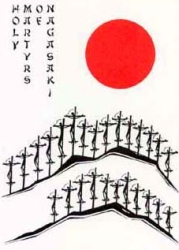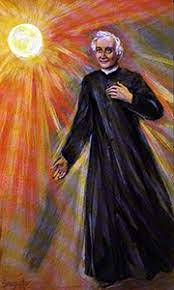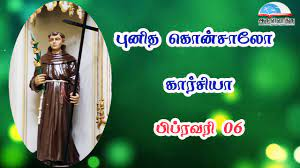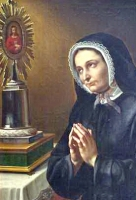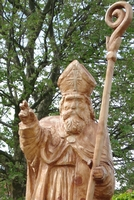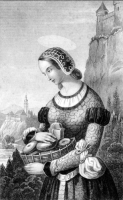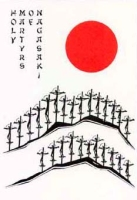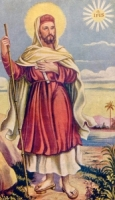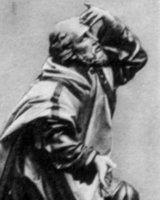Martyrs of Nagasaki
மறைசாட்சியாளர் பவுல் மீகி மற்றும் தோழர்கள் Paul Miki und Gefährten SJ
பிறப்பு
1565,
சியோட்டோ Kyoto, ஜப்பான்
இறப்பு
5 பிப்ரவரி,
1597 நாகசாகி, ஜப்பான்
புனிதர்பட்டம்: 8 ஜூன் 1862, திருத்தந்தை 9 ஆம் பயஸ்
இவர் ஜப்பான் நாட்டில் வாழ்ந்த ஓர் கிறிஸ்தவ பெற்றோரின் மகனாகப் பிறந்தார். இவர் தனது 22 ஆம் வயதில் இயேசு சபையில் சேர்ந்தார். மிகச் சிறந்த மறையுரையாளரான இவர், ஜப்பான் நாட்டில் சிறப்பாக மறைப்பணியாற்றினார். 1587 ஆம் ஆண்டு சோகுண்டோயோடோமி ஹிடேயோஷி Shogun Toyotomi Hideyoshi என்பவர் இட்ட கட்டளையின் பேரில் இப்புனிதர் பிடிக்கப்பட்டு தனித்தீவிற்கு கொண்டுச் செல்லப்பட்டு சிறையிலடைக்கப்பட்டார். இருப்பினும் இவர் ஆற்றியப் பணி மக்களிடையே தீப்போல பரவியது. இவரின் தோழர்களும் மறைப்பணியை சிறப்பாக ஆற்றினர். கிறிஸ்தவ மக்கள் பெருகினர். இதனால் சோகுன் டோயோடோமி ஆத்திரமடைந்து 25 தோழர்களையும் பிடித்து சிறையிலடைத்தான். பின்னர் நாகசாகி நகருக்கு இழுத்துச் செல்லப்பட்டு சிலுவையில் அடித்து கொல்லப்பட்டார்கள்
Also known as
• Nagasaki Martyrs
• Saint Paul Miki and Companions
• Saint Peter Baptist and Companions
Profile
Twenty-six Franciscan and Jesuit missionaries and Japanese converts crucified together by order of Toyotomi Hideyoshi.
Following their arrests, they were taken to the public square of Meako to the city's principal temple. They each had a piece of their left ear cut off, and then paraded from city to city for weeks with a man shouting their crimes and encouraging their abuse. The priests and brothers were accused of preaching the outlawed faith of Christianity, the lay people of supporting and aiding them. They were each repeatedly offered freedom if they would renounce Christianity. They each declined.
• Saint Antony Deynan
• Saint Bonaventure of Miyako
• Saint Cosmas Takeya
• Saint Francis Blanco
• Saint Francis of Nagasaki
• Saint Francis of Saint Michael
• Saint Gabriel de Duisco
• Saint Gaius Francis
• Saint Gundisalvus Garcia
• Saint James Kisai
• Saint Joachim Saccachibara
• Saint John Kisaka
• Saint John Soan de Goto
• Saint Leo Karasumaru
• Saint Louis Ibaraki
• Saint Martin of the Ascension
• Saint Matthias of Miyako
• Saint Michael Kozaki
• Saint Paul Ibaraki
• Saint Paul Miki
• Saint Paul Suzuki
• Saint Pedro Bautista Blásquez y Blásquez
• Saint Peter Sukejiroo
• Saint Philip of Jesus
• Saint Thomas Kozaki
• Saint Thomas Xico
Died
• crucified on 5 February 1597 at Tateyama (Hill of Wheat), Nagasaki, Japan
• the Japanese style of crucifixion was to put iron clamps around the wrists, ankles and throat, a straddle piece was placed between the legs for weight support, and the person was pierced with a lance up through the left and right ribs toward the opposite shoulder
Canonized
8 June 1862 by Pope Pius IX
Blessed Alfonso Maria Fusco
Profile
Son of Giuseppina Schiavone and Aniello Fusco, the eldest of five children in a pious peasant family. The couple had been unable to have children until a visit to the relics of Saint Alphonsus Maria d' Liguori; there they received the message that they would have a son, name him Alfonso, and that he would led the life of a beati. Confirmed and received his first Communion at age seven, and at eleven he announced his intent to become a priest. Entered the seminary of Nocera dei Pagani on 5 November 1850. Ordained 29 September 1863.
Noted for his devotion to the liturgy, and as a gentle, paternal confessor. In September of 1878, he, Maddalena Caputo of Angri (Sister Crocifissa), and three young women formed what would become the Congregation of the Baptistine Sisters of the Nazarene, devoted to the care and education of poor orphans, abandoned children, and youth at risk; their first house was soon known as the Little House of Providence.
Along with the usual problems of more needs than resources, the new congregation faced serveral internal trials. False accusations were made about Father Alfonso, and Bishop Vitagliano tried to remove him as the congregation's director. The daughter house in Rome tried to break away from the congregation, even locking the doors to the house when Alfonso came to see them. At one point, Cardinal Respighi, Vicar of Rome, recommended that he resign for the good of the congregation. He was, however, vindicated in the end, remained as director, and saw the congregation through it's early, difficult years. Today they work in fifteen countries around the world.
Born
23 March 1839 in Angri, Salerno, diocese of Nocera-Sarno, Italy
Died
6 February 1910 in Angri, Salerno, Italy of natural causes
Beatified
7 October 2001 by Pope John Paul II
Saint Dorothy of Caesarea
செசாரியா_நகர்ப்_புனித_டாரத்தி (-321)
பிப்ரவரி 06
இவர் (#DorothyOfCaesarae)கப்பதோசியில் உள்ள செசாரியாவில் பிறந்தவர்.
சிறு வயது முதலே தன்னை ஆண்டவருக்கு அர்ப்பணித்து வாழ்ந்த இவரை உரோமை மன்னன் தியோகிளசியனிடம் ஆளுநராக இருந்த சாப்ரிகுஸ் என்பவன், உரோமைக் கடவுளுக்குப் பலி செலுத்தச் சொன்னான். அதற்கு இவர் மறுப்பபுத் தெரிவித்தது மட்டுமல்லாமல், ஆண்டவர்மீது கொண்ட நம்பிக்கையில் உறுதியாக இருந்ததால், அவன் இவரைப் பலவாறாகச் செய்தான்.
மேலும் உரோமை அரசாங்கத்தில் வழக்குரைஞராகப் பணியாற்றிய தியோபிளஸ் என்பவன் இவரிடம், "நீதான் இயேசுவின் மணவாட்டியாயகற்றே! அதனால் அவருடைய தோட்டத்திலிருந்து மலர் பறித்து வா" என்று எள்ளி நகையாடினான். இதற்கு இவர் எதுவும் பேசாமல் அமைதியாக இருந்தார்.
321 ஆம் ஆண்டு பிப்ரவரி திங்கள் 6 ஆம் நாள் இவர் கொல்லப்படுவதற்கு முன்பாகச் சிறுவன் ஒருவன் கையில் மலர்கள் மற்றும் பழங்களோடு வந்து, அவற்றை டோரத்தியைக் கேலி செய்த தியோபிளஸிடம் கொடுத்துவிட்டு மறந்தான். உண்மையில் சிறுவன் வடிவில் வந்தது வானதூதரே. இதையறிந்த தியோபிளஸ் மனம்மாறிக் கிறிஸ்துவை ஏற்றுக் கொண்டான்.
டோரத்தி கொல்லப்பட்ட சில நாள்களுக்குப் பிறகு தியோபிளசும் ஆண்டவர் மீது கொண்ட நம்பிக்கைக்காகக் கொல்லப்பட்டான்.
Also known as
Dora, Dorothea
Profile
Apochryphal martyr whose story has been beautifully told, and was popular for many years. Having made a personal vow of virginity, she refused to marry, or to sacrifice to idols. She was tried, tortured, and sentenced to death for her faith by the prefect Sapricius. The pagan lawyer Theophilus said to her in mockery, "Bride of Christ, send me some fruits from your bridegroom's garden." Before she was executed, she sent him, by a six-year-old boy who is thought to have been an angel, her headress which had the fragrance of roses and fruits. Seeing this gift, and the miraculous messenger who brought them, Theophilus converted, and was martyred himself. This story has been variously enlarged through the years. In some places, trees are blessed on her feast day because of her connection with a blooming, fruitful miracle.
Died
martyred 6 February 311 at Caesarea, Cappodocia during the persecution of Diocletian
Patronage
• brewers
• brides
• florists
• gardeners
• midwives
• newlyweds
• Pescia, Italy
Saint Amand of Maastricht
Also known as
• Apostle of Belgium
• Apostle of Flanders
• Amand of Belgium
• Amand of Elnone
• Amand of France
• Amandus, Amantius, Amatius
Profile
Lived some time as a hermit, then became a monk at age 20 at the Abbey of Saint Martin at Tours, France. When he took the cowl, his family tried to kidnap him to bring him home for “deprogramming”, but failed. Given a commission to wander and preach, he evangelized in France, Flanders, Carinthia, Gascony, and Germany, sometimes getting beaten by the locals for his trouble. Bishop of Maastricht, Netherlands in 649. Founded several monasteries and convents. Abbot of the monastery at Elnone-en-Pevele, France. Friend and spiritual director of Saint Humbert of Pelagius, and was assisted in his work by Saint Acharius. In his declining years he retired to Elnon Abbey, where he was the spiritual teacher of Saint Chrodobald of Marchiennes, and ended his days as a prayerful monk. His association with brewers and vintners and related fields comes from spending so much time preaching and teaching in beer-making and wine-making regions.
Born
c.584 at Poitou, France
Died
c.679 in the monastery at Elnone-en-Pevele (modern Saint-Amand-les-Eaux), France
Patronage
• against diseases of cattle
• against fever
• against paralysis
• against rheumatism
• against seizures
• against skin diseases
• against vision problems
• Boy Scouts
• bar staff, barkeepers, bartenders
• brewers
• grocers
• hotel keepers, innkeepers
• merchants
• pharmacists, druggists
• vinegar makers
• vine growers
• vintners
• wine-makers
• wine merchants
• 4 cities
Saint Pedro Bautista Blásquez y Blásquez
Also known as
• Peter Baptist Blasquez
• Pietro Battista Blasquez
Profile
Born to the Castillian nobility, Pedro studied at the University of Salamanca and then joined the Franciscans in 1542. Ordained a priest, he taught philosophy and theology, and served as superior of several Franciscan communities. Feeling a call to missionary work, in 1580 he was sent to Mexico where he founded several communities, and then in 1583 he was dispatched to the Philippines.
In 1593, to replace the work of Jesuits who had been expelled from the country in 1590, he and five other friars were sent to Japan where they lived in poverty, cared for lepers, preached the faith, and built schools, churches, convents and hospitals. Father Pedro became known as a miracle worker.
A number of parties, including Buddhist bonzes, European traders, and anti-western Japanese, pushed for a government persecution of these missionaries. The emperor began to fear that missionaries were a prelude to invasion by the West, and ordered them all imprisoned. Arrested in different places, they were all transferred to Nagasaki where they were abused and executed. His last known act was praying for his persecutors. One of the Martyrs of Nagasaki.
Born
1542 in San Esteban del Valle, Avila, Castille (in modern Spain)
Died
• crucified on 5 February 1597 on a hill in Nagasaki, Japan
• his body reported incorrupt after two months exposure to the elements
• local Christians reported seeing Father Pedro celebrating Mass long after his death
Canonized
8 June 1862 by Pope Pius IX
Patronage
• Caceres, Philippines, archdiocese of
• Japan
Saint Vaast of Arras
Also known as
Foster, Gaston, Gastone, Vaat, Vedast, Vedasto, Vedastus
Additional Memorial
• 2 January (discovery of relics)
• 7 February (enshrinement of relics)
• 15 July (translation of relics in Cambrai)
• 1 October (translation of relics)
Profile
Hermit. Worked with Saint Remigius to convert the Franks. Priest. Instructed King Clovis in the faith. His miraculous healing of the blind helped convince some of Clovis's pagan court of the power of God (and led to Vaast's patronage against eye trouble). First bishop of Arras, France in 499. Bishop of Cambrai, France c.510. On the night he died, the locals saw a luminous cloud ascend from his house, apparently carrying away Vaast's soul.
Born
c.453 at Limoges, France
Died
539-540 at Arras, France of natural causes
Patronage
• against eye diseases
• children
• children late learning to walk
• disabled people
• Arras, Boulogne and Saint-Omer, France, diocese of
Saint Mateo Correa-Magallanes
Also known as
Mateo Correa
Additional Memorial
21 May as one of the Martyrs of the Mexican Revolution
Profile
Attended the seminary at Zacatecas, Mexico on a scholarship, beginning 12 January 1881. Ordained on 20 August 1893. Parish priest, assigned to Concepcion de Oro, Mexico from 1898 to 1905. Close friend of the Pro-Juarez family, he baptized Humberto Pro, and gave First Communion to Blessed Miguel Pro. Re-assigned to Colotlan, Mexico from 1908 to 1910. Following the government's repression of the Church in 1910, he went into hiding. Assigned to Valparaiso, Mexico in 1926.
Arrested while en route to a sick call; when he saw the soldiers approaching, he quickly swallowed the host to prevent desecration. Accused of being part of the armed Cristero rebellion, he was jailed in Zacatecas, and then in Durango, Mexico. While in jail, he heard confessions from other prisoners. When the jail's commander, General Ortiz, demanded to know what the condemned men had said, Father Mateo refused. Martyred for being a priest, and for refusing to break the seal of the confessional.
Born
23 July 1866 at Tepechitlán, Zacatecas, Mexico
Died
shot on 6 February 1927 on the outskirts of Durango City, Durango, Mexico
Canonized
21 May 2000 by Pope John Paul II during the Jubilee of Mexico
Blessed Francesco Spinelli
புனிதர் ஃபிரான்செஸ்கோ ஸ்பைனெல்லி
குரு:
(Priest)
பிறப்பு: ஏப்ரல் 14, 1853
மிலன், லொம்பார்டி-வெனீஷியா இராச்சியம்
(Milan, Kingdom of Lombardy-Venetia)
இறப்பு: ஃபெப்ரவரி 6, 1913 (வயது 59)
ரிவோல்டா டி'அ்டா, கிரெமோனா, இத்தாலி இராச்சியம்
(Rivolta d'Adda, Cremona, Kingdom of Italy)
ஏற்கும் சமயம்:
ரோமன் கத்தோலிக்க திருச்சபை
(Roman Catholic Church)
முக்திப்பேறு பட்டம்: ஜூன் 21, 1992
திருத்தந்தை இரண்டாம் ஜான் பவுல்
(Pope John Paul II)
புனிதர் பட்டம்: அக்டோபர் 14, 2018
திருத்தந்தை ஃபிரான்சிஸ்
(Pope Francis)
நினைவுத் திருநாள்: ஃபெப்ரவரி 6
பாதுகாவல்:
ஆசிர்வதிக்கப்பட்ட அருட்சாதனத்தை ஆராதிக்கும் அருட்சகோதரியர் சபை
(Sisters Adorers of the Blessed Sacrament)
புனிதர் ஃபிரான்செஸ்கோ ஸ்பைனெல்லி, இத்தாலி நாட்டின் ரோமன் கத்தோலிக்க திருச்சபையின் குருவும், "ஆசிர்வதிக்கப்பட்ட அருட்சாதனத்தை ஆராதிக்கும் அருட்சகோதரியர் சபை" (Sisters Adorers of the Blessed Sacrament) எனப்படும் சபையை நிறுவியவருமாவார். இவர், "புனிதர் கெல்ட்ரூட் காமன்சோலி" (Saint Geltrude Comensoli) மற்றும் அருளாளர் "லுய்கி மரியா பலஸ்ஸோலோ" (Blessed Luigi Maria Palazzolo) ஆகியோரின் சமகாலத்தவராவார். மேலும், இவருக்கு காமன்சோலியுடன் முந்தைய ஒத்துழைப்பு இருந்தது. ஐவரும் காமன்சோலியும் இணைந்து "பெர்கமோ" (Bergamo) நகரில் ஒரு மத கல்வி நிறுவனத்தை நிறுவினார்கள். அதற்கு முன்னரே, இவர்களின் உறுப்பினர்களிடையே இரட்டை பிளவு காரணமாக, ஸ்பைனெல்லி தமது பணிகளை விட்டு விலக நேர்ந்தது.
கி.பி. 1853ம் ஆண்டு, ஏப்ரல் மாதம், 14ம் நாளன்று, வடக்கு இத்தாலியின் "லொம்பார்டி" (Lombardy) பிராந்தியத்தின் தலைநகரான "மிலன்" (Milan) நகரில் பிறந்த ஃபிரான்செஸ்கோ ஸ்பைனெல்லிக்கு அவர் பிறந்த மறுதினம் திருமுழுக்கு தரப்பட்டது. அவர் தமது சிறு வயதில், தமது பெற்றோருடனும், உடன்பிறந்தோருடனும் மிலனிலிருந்து (Milan) "கிரெமோனா" (Cremona) நகருக்கு புலம்பெயர்ந்து சென்றனர். அவர், கி.பி. 1871ம் ஆண்டின் கோடை காலத்தில், "வர்கோ" நகரில், தமக்கிருந்த கடுமையான முதுகெலும்பு பிரச்சனைக்கு மருத்துவம் செய்து குணப்படுத்தினார். தனது குழந்தைப் பருவத்தில், ஏழை எளியவர்களுக்கும், நோய்வாய்ப்பட்டவர்களுக்கும் அடிக்கடி கிடைக்கும் சந்தர்ப்பங்களில் தமது அம்மாவுடன் சேர்ந்து, சக தோழர்களுக்கு பொம்மை நிகழ்ச்சிகளை நடத்திக் காட்ட விரும்பினார்.
அவரது ஆன்மீக வாழ்க்கைக்கான அழைப்புக்கு, அவரது தாயாரும், குருவாக இருந்த அவரது மாமா "பியேட்ரோ காக்ளியரொளி" (Pietro Cagliaroli) என்பவரும் அவருக்கு ஆதரவு அளித்தனர். பெர்கமோ நகரில் இறையியல் கற்கத் தொடங்கிய இவரை இவரது நண்பர் "அருளாளர் லுய்கி மரிய பலஸ்ஸோ" (Blessed Luigi Maria Palazzolo) என்பவரும் ஊக்கப்படுத்தினார். கி.பி. 1875ம் ஆண்டு, ஆகஸ்ட் மாதம், 14ம் தேதி, குருத்துவ அருட்பொழிவு பெற்றார். விரைவிலேயே, திருத்தந்தை ஒன்பதாம் பயஸ் (Pope Pius IX) அவர்களின் பொது அழைப்பினை ஏற்று, யூபிலி ஆண்டு நிகழ்வுகளில் பங்கேற்க ரோம் நகர் பயணமானார்.
அங்கே, மரிய அன்னை பேராலயத்திற்கும் சென்ற ஸ்பைநெல்லி, அங்கிருந்த குழந்தை இயேசு கெபியினருகே, மறையுரைச் சிந்தனைகளில் ஆழ்ந்தார். அத்துடன், நற்கருணை ஆராதணையில் பெண்கள் ஈடுபடுவதாக இவர் கண்ட திருக்காட்சி, தாம் சொந்தமாக ஒரு சபையை நிறுவ இவருக்கு உந்துசக்தியாக விளங்கியது. ரோமிலிருந்து திரும்பியதும் ஒரு மாலை பள்ளியில் கல்விப் பணிகளை நடத்தினார்.
கி.பி. 1882ம் ஆண்டு, டிசம்பர் மாதம், 15ம் தேதி, பெர்கமோ (Bergamo) நகரில், புனிதர் கெல்ட்ருட் காமென்சோலி (Saint Geltrude Comensoli) உடன் இணைந்து "நற்கருணை அருட்சகோதரியார்" (Sacramentine Sisters) சபையை தொடங்கினார். இது, நற்கருணைக்கு அர்ப்பணிக்கப்பட்ட இச்சபை, நற்கருணை ஆராதனைப் பணிகளில் மட்டுமே ஈடுபடும். சபையின் முதல் கான்வென்ட், "வயா சான் அன்டோனினோ'வில்" (Via San Antonino) திறக்கப்பட்டது. நகரில் ஏற்பட்ட தொடர் பேரழிவுகள் மற்றும் நிதி நெருக்கடிகளின் காரணமாக, இந்த இல்லம் தோல்வியடைந்த காரணத்தால், கி.பி. 1889ம் ஆண்டு, மார்ச் மாதம், 4ம் தேதியன்று, அதை விட்டுவிட வேண்டிய கட்டாயம் ஸ்பைநெல்லிக்கு ஏற்பட்டது.
பெர்மாமோவில் நடந்ததை எண்ணி மன வேதனையடைந்த ஸ்பைநெல்லி, "கிரெமோனா" (Cremona) நகரிலுள்ள "ரிவோல்டா டி'அ்ட்டா" (Rivolta d'Adda) எனும் இடத்துக்கு வந்து சேர்ந்தார். அவரது குருத்துவ கடமைகளை நிறைவேற்றுவதற்காக கிரெமோனாவுக்கு வருமாறும், மறைமாவட்ட ஆயர் அவரை அழைத்திருந்தார். கி.பி. 1892ம் ஆண்டு, அவர், "ஆசிர்வதிக்கப்பட்ட அருட்சாதனத்தை ஆராதிக்கும் அருட்சகோதரியர் சபையை" (Sisters Adorers of the Blessed Sacrament) நிறுவினார். இச்சபைக்கு, பின்னாளில் கி.பி. 1897ம் ஆண்டு, "கிரெமோனா ஆயர்" (Bishop of Cremona) "கெரேமியா பொனோமெல்லி" (Geremia Bonomelli) அவர்களின் மறைமாவட்ட அங்கீகாரம் கிட்டியது.
ஃபிரான்செஸ்கோ ஸ்பைனெல்லி, கி.பி. 1913ம் ஆண்டு, ஃபெப்ரவரி மாதம், 6ம் தேதி மரித்தார்.
கி.பி. 1926ம் ஆண்டு, டிசம்பர் மாதம், 11ம் நாளன்று, இவரது சபைக்கு, திருத்தந்தை அவையின் பாராட்டுப் பத்திரம் வழங்கப்பட்டது. பின்னர், கி.பி. 1932ம் ஆண்டு, ஃபெப்ரவரி மாதம், 27ம் நாளன்று, திருத்தந்தை பதினோராம் பயஸ் (Pope Pius XI) முழு அங்கீகாரம் வழங்கினார். இவர்களது சபை, "அர்ஜென்ட்டினா" (Argentina) மற்றும் "செனெகல்" (Senegal) உள்ளிட்ட நாடுகளில் செயல்பாட்டில் உள்ளது. 2005ம் ஆண்டு கணக்கெடுப்பின்படி, மொத்தமிருந்த 59 இல்லங்களில், 436 மறைப்பணியாளர்கள் இருந்தனர்.
Profile
As a child, Francesco would put on puppet shows for other kids. With his mother, he would visit and help the poor and sick in his city. Francesco studied in Bergamo, Italy, and ordained as a priest in 1875. Later that year, while in Rome, Italy to celebate the Jubilee, he had a vision of women continually adoring the Blessed Sacrament. Back in Bergamo he began teaching in the seminary by day, running an evening school for the poor of his parish by night. On 15 December 1882 he realized the fulfillment of his vision when he helped found the Sisters Adorers of the Blessed Sacrament in Bergamo. Transferred to the diocese of Cremona, Italy on 4 April 1889 where the Sisters cotninue their work of adoring Christ in the Eucharist and in their care for their poor.
Born
14 April 1853 in Milan, Italy
Died
6 February 1913 in Rivolta d'Adda, Cremona, Italy of natural causes
Beatified
21 June 1992 by Pope John Paul II at the Marian Shrine of Caravaggio
Canonized
on 6 March 2018, Pope Francis promulgated a decree of a miracle obtained through the intercession of Blessed Francisco
Blessed Mary Teresa Bonzel
Also known as
• Aline Bonzel
• Maria Theresia
• Regina Christine Wilhelmine Bonzel
Profile
Franciscan tertiary by age 20. She wanted to enter religious life, but her family strongly opposed it. With eight other women she took the veil as part of the new community of Sisters of Saint Francis of Perpetual Adoration, and became its director, taking the name Mother Mary Teresa. By the time of her death the order had sisters all over the world, and had established schools, hospitals, and orphanages.
Born
17 September 1830 at Olpe, North Rhine-Westphalia, Germany as Aline Bonzel
Died
6 February 1905 at Olpe, North Rhine-Westphalia, Germany of natural causes
Beatified
• 10 November 2013 by Pope Francis
• the beatification recognition was celebrated at the cathedral of Paderborn, Germany with Cardinal Angelo Amato presiding
• her beatification miracle involved the cure of a four-year-old boy in Colorado Springs, Colorado
Saint Gundisalvus Garcia
புனிதர் கொன்சாலோ கார்ஸியா
(St. Gonzalo Garcia)
ஃபிரான்சிஸ்கன் சபையின் குருத்துவம் பெறாத பொதுநிலை சகோதரர் மற்றும் மறைசாட்சி:
(Franciscan Lay Brother and Martyr)
பிறப்பு: ஃபெப்ரவரி 5, 1557
வாசை, மும்பை, போர்ச்சுகீசிய இந்தியா
(Vasai, Mumbar, Portuguese India)
இறப்பு: ஃபெப்ரவரி 5, 1597
நாகசாகி, ஜப்பான்
(Nagasaki, Japan)
ஏற்கும் சமயம்:
ரோமன் கத்தோலிக்க திருச்சபை
(Roman Catholic Church)
முக்திபேறு பட்டம்: செப்டம்பர் 14, 1627
திருத்தந்தை எட்டாம் அர்பன்
(Pope Urban VIII)
புனிதர் பட்டம்: ஜூன் 8, 1862
திருத்தந்தை ஒன்பதாம் பயஸ்
(Pope Pius IX)
நினைவுத் திருநாள்: ஃபெப்ரவரி 6
முக்கிய திருத்தலங்கள்:
புனிதர் கொன்சாலோ கார்ஸியா ஆலயம், காஸ், வாசை
(St. Gonsalo Garcia Church, Gass, Vasai, India)
பாதுகாவல்:
ரோமன் கத்தோலிக்க உயர் மறைமாவட்டம், மும்பை
(Roman Catholic Archdiocese of Bombay, East Indian Community)
புனிதர் கொன்சாலோ கார்ஸியா, போர்ச்சுகீசிய இந்தியாவில் பிறந்து, ஜப்பான் நாட்டில் மறை சாட்சியாக மரித்த ரோமன் கத்தோலிக்க திருச்சபையின் இருபத்தாறு புனிதர்களுள் ஒருவர் ஆவார். இவர் ஒரு ஃபிரான்சிஸ்கன் பொதுநிலையினர் சகோதரர் (Franciscan Lay Brother) ஆவார். இந்தியாவில் பிறந்து, அருட்பொழிவு செய்யப்பட்ட முதல் புனிதரும் இவரேயாவார். மும்பை நகரின் வடக்கே, சுமார் முப்பது கிலோமீட்டர் தொலைவில் அமைந்துள்ள மேற்கத்திய கடற்கரை நகரான வாசை என்னுமிடத்தில் பிறந்தார். இவர் வாழ்ந்த அக்காலத்தில், அப்பகுதி போர்ச்சுகீசிய காலணித்துவ ஆட்சியின்கீழ் இருந்தது.
இவரது தந்தை ஒரு போர்ச்சுகீசிய படை வீரர் ஆவார். தாயார் “கொங்கண்” (Konkan) மொழி பேசும் ஒரு இந்தியப் பெண் ஆவார். இவர், ஜப்பான் ஃபிரான்சிஸ்கன் சபைத்தலைவரான புனிதர் பீட்டர் பாப்டிஸ்டின் வலக்கரமாக இருந்தார்.
"குன்டி ஸ்லாவுஸ் கார்ஸியா" எனும் இயற்பெயர் கொண்ட இவர், வாசையில் பணியாற்றிய 'செபஸ்தியோ கான்கால்வ்ஸ்' என்னும் இயேசு சபை குருவிடம் கல்வி பயின்றார். இயேசு சபையினரிடமே கி.பி. 1564 முதல் 1572 வரை எட்டு வருடம் பயின்றார். தனது 15ம் வயதில் குரு செபஸ்தியோவுடன் ஜப்பான் சென்றார். ஜப்பானிய மொழியை இவர் எளிதில் கற்றதால், அம்மக்களின் நன்மதிப்பைப் பெற்றார். இவர் அங்கிருந்து ஆல்கோ சென்று வணிகம் செய்தார். அது தென்கிழக்காசியா முழுவதும் பல கிளைகள் கொண்டு பரவியது.
இவரின் கனவான இயேசு சபை குருவாவது நிறைவடையாமலேயே இவர் ஃபிலிப்பைன்ஸ் நாட்டில் உள்ள மணிலாவுக்கு பொதுநிலை மறைப்பணியாளராய் சென்றார். அங்கே ஃபிரான்சிஸ்கன் சபைக் குருவான பீட்டர் பாப்டிஸ்டினால் தூண்டப்பட்டு அச்சபையில் பொதுநிலை சகோதரராக சேர்ந்தார். தொழு நோயாளர்களோடு அங்கே பணியாற்றினார். அப்போதே அவர் அச்சபையில் திருநிலைப்பாட்டினைப் பெற்றார்.
மே 26, 1592ல் ஃபிலிப்பைன்ஸ் நாட்டின் எசுபானிய ஆளுனரால் அரசு சார்பாக ஜப்பானுக்கு அனுப்பப்பட்டார். அங்கே நான்காண்டுகள் பணிபுரிந்த பின்னர், அப்போது ஜப்பானிய சர்வாதிகாரியால் ஆட்சி விரோதச் செயல்களில் ஈடுபட்டதாக குற்றம் சாட்டப்பட்டு அவர்கள் தங்கியிருந்த மியாகோ (கியோத்தோ) என்னும் இடத்திலிருந்த மடத்திலேயே 8 டிசம்பர் 1596 அன்று சிறைவைக்கப்பட்டார். சிலநாட்களுக்கு பின் மாலை செபம் செய்து கொண்டிருந்தபோது அவர்கள் கைது செய்யப்பட்டனர்.
ஜனவரி 3, 1597 அன்று கைது செய்யப்பட்ட 26 பேர்களுடைய இடது காதுகள் அறுத்தெறியப்பட்டன. அவற்றை கிறிஸ்தவர்கள் எடுத்து பாதுகாத்து வந்தனர்.
ஃபெப்ரவரி 5, 1597 அன்று அவர்களை சிலுவையில் அறைய ஆணை பிறப்பிக்கப்ப்பட்டது. சிலுவையில் அறையும் இடத்தை கார்சியா முதலில் அடைந்தார். அவர் முதலில் அங்கிருந்த ஒரு சிலுவையின் அருகில் சென்று, "இது எனக்கானதா?" என்றார். "இது இல்லை" என்று பதில் கூறி அவரை வேறு சிலுவையிடம் கூட்டிச்சென்றனர். சிலுவையை அடைந்ததும் முழந்தாள் பணிந்து அதனைத் தழுவினார். அவரோடு கைது செய்யப்பட்ட மற்றெல்லோரையும் சிலுவையில் அறைந்தார்கள். பின்பு அவரை இரண்டு ஈட்டி கொண்டு இதயத்தில் குத்தினர். இவர் சிலுவையில் சாகும்வரை இறை புகழ் பாடிக்கொண்டே இருந்தார்.
புனிதர் பட்டமளிப்பு:
கி.பி. 1927ல் கார்சியாவும் அவருடன் இரத்த சாட்சிகளானவர்களும் வணக்கத்திற்குரியவர்கள் என திருத்தந்தை எட்டாம் அர்பன் (Pope Urban VIII) அவர்களால் அறிவிக்கப்பட்டனர். ஜூன் 8, 1862 அன்று திருத்தந்தை ஒன்பதாம் பயஸ் (Pope Pius IX) அவர்களால் இவர்கள் அனைவரும் புனிதர்களாக அருட்பொழிவு செய்யப்பட்டது.
இவர் ஒரு போர்ச்சுகீசிய தந்தைக்கும், கொங்கண் தாய்க்கும் பிறந்தவராதலால் இவர் இந்தியப் புனிதராக கருதப்படுவதில்லை. இவர் கத்தோலிக்க திருச்சபையில் அதிகாரப்பூர்வ பட்டியலில் போர்ச்சுகீசிய புனிதராவார்.
Also known as
Gonsalo, Gonsalvo, Gonzalo, Gonçalo
Profile
His father was a Portugese soldier and immigrant to India, his mother an Indian convert. Gundisalvus grew up a Christian, and served as a lay catechist, working for the Jesuits. Successful businessman in Japan and Macao. Became an Alcantarine Franciscan lay brother in Manila in the Philippines in 1591. Returned to Japan with Saint Peter Baptist to act as interpreter. He stuttered when speaking Portuguese, but when arrested for his faith, he was flawless in Japanese when facing his judges. One of the Martyrs of Nagasaki.
Born
1556 at Bassein, Maharashtra, India
Died
crucified on 5 February 1597 at Nagasaki, Japan
Canonized
8 June 1862 by Pope Pius IX
Patronage
• Bombay, India, archdiocese of
• Bombay, India, city of
• East Indians
Saint Elian of Emesa
Also known as
• Elian of Homs
• Ellien, Julian
Profile
The son of a senior officer in the imperial Roman army, Elian trained as a physician. He was a convert to Christianity, baptized by Saint Silvanus of Emesa. He developed a reputation of healing by prayer as much as by medicine, and treated the poor sick for free. Caught ministering to Christians awaiting execution, Elian was ordered to renounce the faith; he refused. To change his mind, Elian was imprisoned and tortured for several months; when he still refused, he was executed by his father. Martyr.
Born
Emesa, Phoenicia (modern Homs, Syria)
Died
• nails driven into his hands, feet and head c.312
• in 432 a church was built on the site of his execution
• relics enshrined in a small chapel to the the right of the crypt in the church
Saint Brinolfo Algotsson
Also known as
Brynolf
Profile
Born to the nobility, the son of Algot Brynolfsson. Educated at the cathedral of Skara, Sweden, and in Paris, France where he heard lectures by Saint Thomas Aquinas; Brinolfo was noted all his life for his learning. Had an extensive background in theology and canon law. Dean of the Linköping chapter and bishop of Skara in 1278; he served for over 38 years. Active in the political life of the country, Brinolfo worked to ensure that the needs and teachings of the Church became part of public policy. He supported missionaries in Sweden. When his work ran afoul of the absolutist King Magnus Ladulas c.1288, Brinolfo was forced briefly into exile. Wrote on theology, church administration, and poetry for feasts and holy days.
Died
6 February 1317 in Skara, Sweden of natural causes
Canonized
• Saint Bridget of Sweden received a vision that revealed the holiness of Brinolfo
• c.1498 by Pope Alexander VI
Saint Mel of Ardagh
Also known as
Mael, Melchno, Melis
Profile
Son of Conis and Saint Darerca, one of their nineteen children. Brother of Saint Melchu. Nephew of Saint Patrick. Travelled with Patrick and helped evangelize Ireland. Ordained bishop of Ardagh, Ireland by Patrick. Reputed to have professed Saint Brigid of Ireland as a nun. He supported himself by working with his hands, and gave to the poor anything beyond the bare minimum.
Because Mel lived with his aunt, Lupait, and helped on her farm, slanderous gossip developed about their relationship. Patrick came to investigate. To prove that God was on their side, Mel and Lupait each prayed for help and then performed a miracle - Mel plowed up a live fish from the farm land, and Lupait packed around a live coal without being burned.
Born
British Isles
Died
c.489 of natural causes
Patronage
• Ardagh, Ireland, diocese of
• Ardagh and Clonmacnois, Ireland, diocese of
Saint Bonaventure of Miyako
Also known as
• Bonaventure of Maeco
• Bonaventure of Miako
Profile
Baptized as an infant, his mother died when he was a baby, and his step-mother sent him to be raised in a Buddhist monastery. When he was judged old enough, he was told about his background. To learn more, he visited the Franciscan convent at Kyoto. There he found a peace he had been looking for, and stayed to become a Franciscan tertiary. Catechist. One of the Martyrs of Nagasaki.
Born
at Kyoto, Japan
Died
crucified on 5 February 1597 at Nagasaki, Japan
Canonized
8 June 1862 by Pope Pius IX
Saint Guethenoc
Also known as
Guéhénec, Guéhenneuc, Guéhenocus, Guéneuc, Guennec, Guénoc, Guethenoc, Guéthénoc, Guéthnec, Gueveneux, Guézennec, Guinau, Guinnous, Guinou, Guithénoc, Guithern, Gwezheneg, Hinec, Ithizieux, Izinieux, Venec, Veneuc, Vennec, Venoc, Vinec, Wéthénoc, Wihenoc
Profile
Son of Saint Fragan and Saint Gwen; brother of Saint Jacut and Saint Gwenaloe. Spiritual student of Saint Budoc. With Jacut, he was driven from Britain to Brittany in the 5th century by invading Saxons.
Saint Ina of Wessex
Also known as
Ine, Ini, Im
Profile
King of Wessex (in modern England) from 688 to 726. Known as a great warrior, lawgiver and justice, he restored Glastonbury Abbey. Married to Saint Ethelburga of Wessex who helped shift his focus from earthly to spiritual concerns. In 726, Ina abdicated his throne, he and Ethelburga moved to Rome, Italy where he spent his remaining days as a penitential monk and prayful pilgrim to the tombs of the martyrs.
Born
in Wessex, England
Died
727 at Rome, Italy of natural causes
Saint Hildegund
Also known as
Hilda, Hildegundis
Profile
Born to the 12th-century German nobility, the daughter of Count Herman of Lidtberg. Countess, married to Count Lothair. Mother of three, one of whom died in his youth; the other two were Blessed Herman Joseph and Blessed Hadewych. Widowed, in 1178 she turned her castle at Meer, Germany, a former fortress, into a Premonstratensian convent. Against strong family opposition, she and her daughter joined the Order. Prioress of the convent.
Died
6 February 1183 of natural causes
Saint Antony Deynan
Also known as
• Antony Dainan
• Anthony, Antonius
Profile
Son of a Chinese father and Japanese mother. Altar boy. Educated by the Jesuits in Nagasaki and the Franciscans in Osaka. Franciscan tertiary. One of the Martyrs of Nagasaki at age 13.
Born
c.1583 at Nagasaki, Japan
Died
crucified on 5 February 1597 at Nagasaki, Japan
Canonized
8 June 1862 by Pope Pius IX
Saint Guarinus of Palestrina
Profile
Born to the Italian nobility. Priest. Canon of the catehdral of Bologna, Italy. Augustinian canon c.1104. Chosen bishop of Pavia, Italy c.1139, but adamantly refused the appointment, citing his inadequacy to the task. Elevated to cardinal-bishop of Palestrina in 1144 by Pope Lucius II.
Born
c.1080 in Bologna, Italy
Died
1159 of natural causes
Canonized
by Pope Alexander III
Blessed Angelus of Furci
Profile
Augustinian hermit. Studied at Paris, France. Taught theology at Naples, Italy. Preacher, known for his great learning. Refused multiple bishoprics.
Born
1246 at Furci, in the Abruzzi region, diocese of Chieti, Italy
Died
6 February 1327 at Naples, Italy
Beatified
20 December 1888 by Pope Leo XIII (cult confirmed)
Blessed Diego de Azevedo
Profile
Courtier to Prince Ferdinand. He was sent to escort the fiance' of the prince, but when Diego arrived he found that she had recently died. He heard Saint Dominic de Guzman preaching, and decided to give up court life for religious. He travelled with Saint Dominic and became one of the first Dominicans. Bishop of Osma, Spain in 1201.
Died
30 December 1207 of natural causes
Saint Relindis of Eyck
Also known as
• Relindis of Maaseik
• Renildis, Renula, Renule
Profile
She and her sister Herlindis were nuns in Valenciennes in northern France. An artist, Relindis was known for her painting and embroidery. Abbess in Maaseik, Belgium.
Died
c.750 in Tongres, Brabant, Astrasia (in modern Belgium) of natural causes
Saint Ethelburga of Wessex
Profile
Queen of Wessex (part of modern England) from 688 to 726, married to Saint Ina of Wessex. Late in life, Ina abdicated, and the couple moved to Rome, Italy where they spent their time caring for English pilgrims, and praying at the tombs of the saints.
Born
England
Died
Rome, Italy of natural causes
Saint Theophilus the Lawyer
Also known as
• Theophilus Scholasticus
• Theophilus of Caesarea
Profile
Pagan lawyer brought to the faith through a miracle received through the intervention of Saint Dorothy of Caesarea. Martyr.
Born
beheaded in 300 in Caesarea, Cappadocia (in modern Turkey)
Blessed Antimo of Urbino
Also known as
• Antimo of Saltara
• Antonio
Profile
Twin brother of Blessed Giovanni of Urbino. Franciscan tertiary. Hermit. Known for his life of penance, and as a miracle worker.
Died
1438 in Saltara, Pesaro, Italy
Blessed Teresa Fernandez
Profile
Founded and led the Mercedarian monastery of the Consolation in Lorca, Spain.
Died
Consolation monastery, Lorca, Spain of natural causes
Saint Jacut
Profile
Son of Saint Fragan and Saint Gwen; brother of Saint Guethenoc and Saint Gwenaloe. Spiritual student of Saint Budoc. With Guethenoc, he was driven from Britain to Brittany in the 5th century by invading Saxons.
Saint Melchu of Armagh
Profile
Son of Conis and Saint Darerca, one of their nineteen children. Brother of Saint Melchu. Nephew of Saint Patrick. Travelled with Patrick and helped evangelize Ireland. Ordained bishop of Armagh, Ireland by Patrick.
Born
British Isles
Saint Silvanus of Emesa
Also known as
Silvano
Profile
Bishop of Emesa, Phoenicia for 40 years. Martyred in the persecutions of Maximian.
Died
thrown to wild animals c.311 in Emesa, Phoenicia (modern Homs, Syria)
Saint Tanco of Werden
Also known as
Tancho, Tanchon, Tatta
Profile
Born
Ireland
Died
808
Saint Gerald of Ostia
Profile
Benedictine monk. Prior of Cluny Abbey. Bishop of Ostia, Italy. Papal legate to France, Spain and Germany. Imprisoned by the German emperor, Henry V.
Died
1077
Patronage
Velletri, Italy
Saint Mucius the Lector
Profile
Lector for bishop Saint Silvanus of Emesa, Phoenicia. Martyred with Silvanus during the persecutions of Maximian.
Died
thrown to wild animals c.311 in Emesa, Phoenicia (modern Homs, Syria)
Saint Luke the Deacon
Profile
Deacon for and martyred with Bishop Silvanus of Emesa, Phoenicia. Martyred in the persecutions of Maximian.
Died
thrown to wild animals c.311 in Emesa, Phoenicia (modern Homs, Syria)
Saint Antholian of Auvergne
Also known as
Antoliano, Anatolianus
Profile
Martyred in the persecutions of Valerian and Gallienus.
Died
c.265 in Auvergne, France
Saint Amand of Nantes
Also known as
Amandus, Amantius, Amatius
Profile
Founder and first abbot of the monastery at Nantes, France.
Died
7th century of natural causes
Saint Amand of Moissac
Also known as
Amandus, Amantius, Amatius
Profile
Founder and first abbot of the monastery of Moissac, France.
Died
644 of natural causes
Saint Mun of Lough Ree
Profile
Fifth-century bishop in Ireland, consecrated by his uncle, Saint Patrick. In later life he retired to live as a hermit on the island of Lough Ree, Ireland.
Saint Victorinus of Auvergne
Profile
Martyred in the persecutions of Valerian and Gallienus.
Died
c.265 in Auvergne, France
Saint Andrew of Elnone
Profile
Monk. Spiritual student of Saint Amandus of Maastricht at Elnone-en-Pevele, France. Abbot there.
Died
c.690
Saint Liminius of Auvergne
Profile
Martyred in the persecutions of Valerian and Gallienus.
Died
c.265 in Auvergne, France
Saint Cassius of Auvergne
Profile
Martyred in the persecutions of Valerian and Gallienus.
Died
c.265 in Auvergne, France
Saint Maximus of Auvergne
Profile
Martyred in the persecutions of Valerian and Gallienus.
Died
c.265 in Auvergne, France
Blessed Francesca of Gubbio
Profile
Franciscan tertiary.
Died
1360 of natural causes
Saint Saturninus
Profile
Martyr.
Saint Theophilus
Profile
Martyr.
Saint Revocata
Profile
Martyr.

